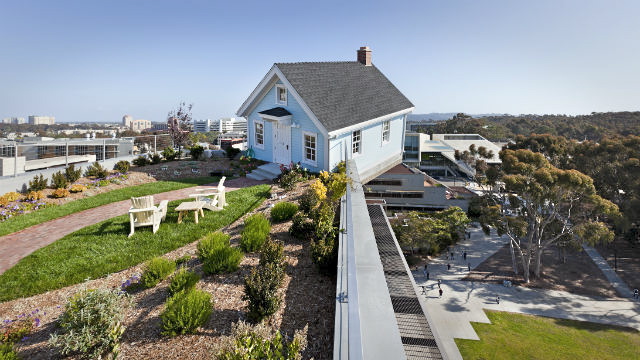Daily Business Report — Aug. 14, 2014
The severe drought in California spurred efforts to push for a new water bond.
$7.5 Billion Water Bond Headed to Voters
California voters will be asked to authorize $7.5 billion to bolster the state’s water supply, infrastructure and ecosystems in November, as lawmakers and Gov. Jerry Brown on Wednesday struck a long-sought deal to move a new water bond to the ballot.
An extraordinary drought that has strained California’s water supply spurred a concerted push for a new water bond. Lawmakers moved to replace an $11.1 billion previously slated for the ballot, convinced that voters would reject it.
Instead, voters will see a $7.5 billion measure that contains significantly less money for Delta restoration. The final sum represents a compromise both from Republicans, who called for $3 billion for surface storage projects, and from Brown, who sought an overall total closer to $6 billion.
In a pivotal concession, Democrats and the governor agreed to boost the amount of money for surface storage projects to $2.7 billion. Republicans had opposed a pact between Brown and Democrats containing $2.5 billion for new dams and reservoirs.
While money for storage and the Delta occupied a central place in negotiations, the bond would also allocate billions to provide clean drinking water to thirsty communities, guard against floods and treat or reuse water.
In the end, the vote tally masked the twisting and divisive debate that preceded Wednesday’s deal. Assembly members voted 77-1 in favor of the measure and then broke into applause. In the Senate, the margin was 37-0.
The governor signed the bill Wednesday night.
— The Sacramento Bee

California Senate Approves Cell Phone ‘Kill Switch’
The California Senate on Wednesday approved a bill that would require cell phone manufacturers to include a switch that would render the phone inoperable if it falls into the wrong hand. Nearly four months after the Legislature shot down a similar measure, the bill will now head to Gov. Jerry Brown for his signature. If signed, California will become the second state in the nation to require such legislation, after Minnesota.
The bill would require phones made after July 1, 2015 to include a feature that would allow owners to remotely deactivate their phones if the devices were stolen.
Several phone makers have already announced features on their phones to deter theft. Microsoft will offer an update for its “Find My Phone” program for all phones running Windows 8.0 and newer. Google announced that its Androit will include a factory reset feature to deter thefts.
— Times of San Diego

General Atomics Gets Navy Contract
For John F. Kennedy Aircraft Carrier
General Atomics has been awarded a contract by the U.S. Naval Air Systems Command to produce an electromagnetic aircraft catapult system and advanced arresting gear for the future John F. Kennedy aircraft carrier (CVN 79). The John F. Kennedy is the second of the Gerald R. Ford-class aircraft carriers. It is scheduled to be delivered to the Navy in 2023.
GA Electromagnetic Systems Group will manufacture the components at its 367,000-square-foot manufacturing facility in Tupelo, Miss.
Junior Achievement to Honor 3 San Diego Leaders



General Atomics’ Linden Blue, Retired Navy Rear Adm. Ronne Froman and Sharp HealthCare CEO Michael Murphy will be honored by Junior Achievement of San Diego on Sept. 17 at its annual Business Hall of Fame dinner and awards program at The Grand Del Mar. Proceeds from the event will support Junior Achievement’s programs that provide kindergarten through 12th grade students the skills needed to succeed in the global economy.
The Hall of Fame Laureates:
Linden Blue is co-owner and vice chairman of General Atomics, the global high-technology company and world leader in unpiloted aerial systems, high-power electromagnetics, fusion and fission. His activities include development of advanced reactors (such as the innovative waste-to-energy reactor) and coordination of GA’s Washington, D.C., operations.
Ronne Froman served in the Navy for 31 years and retired a two-star admiral. In her last Navy job, she was the director of ashore readiness for the chief of naval operations, responsible for nearly 90 Navy stations and bases around the world with a $7 billion budget. After retirement, she joined the San Diego Unified School District as the chief of business operations, then became CEO of the San Diego Imperial Counties chapter of the American Red Cross. In 2005, Froman became the first chief operating officer for the city of San Diego. After, she was senior vice president for the energy group of General Atomics, managing 300 scientists and engineers.
Michael Murphy, president and CEO of Sharp HealthCare, oversees a workforce of more than 17,000 employees, 2,600 affiliated physicians and 2,100 volunteers. Murphy’s career in health care spans more than 30 years. He was appointed to his position in June 1996.

PR Firm to Accept Bitcoin as Payment for Services
KCD Public Relations Inc., a San Diego public relations and marketing firm, said it will begin accepting Bitcoin as a form of payment for its services. The firm is partnering with Coinbase.com, a Bitcoin payment processing company, to handle the conversion of Bitcoin into U.S. dollars. The firm said existing and new KCD PR clients will receive a two percent discount on any Bitcoin-related payments.
Gov. Jerry Brown recently signed into law a bill that formally legalizes the use of Bitcoin and other currencies in the state. KCD PR is one of a growing number of San Diego businesses accepting Bitcoin as a form of payment.
USD Nursing School Receives Grant
The University of San Diego Hahn School of Nursing and Health Science is one of 52 schools to receive its second grant from the Robert Wood Johnson Foundation New Careers in Nursing Scholarship Program. For the 2014-2015 academic year, the school will receive $150,000 to support traditionally underrepresented students who are making a career switch to nursing through an accelerated baccalaureate or master’s degree program.
Competition Offers $5,000 to Design
Downtown San Diego Mobile Park
Ever want to build a park? Now may be your chance.
A new competition is soliciting ideas for temporary “parklets,” or small parks, that could be installed in downtown San Diego. The winner will get $5,000 from the city to fund construction. The contest is a collaboration between the nonprofit advocacy group Downtown San Diego Partnership and City Council President Todd Gloria’s office.
Its purpose is to bring new life to unused spaces in Downtown, said Kris Michel, president and CEO of the Downtown San Diego Partnership. Her organization backs a strategy called “tactical urbanism,” which means creating quick, cheap and sometimes temporary projects that draw foot traffic to Downtown spaces. In June, they helped install temporary pocket park in a vacant lot at 13th Avenue and J Street.
This contest takes the idea a step further by making the park mobile, Michel said. “It takes spaces that might be enlivened for a day or two, and can then move to another side of Downtown and enliven places there,” she said.
“I encourage San Diegans to be innovative, creative and competitive and bring their best mobile parklet designs forward,” said Gloria. “Downtown is a thriving neighborhood, and a mobile parklet designed and developed locally will be a great new community amenity.”
Entries must be received by 5 p.m. on Aug. 25, and the winner will be announced Sept. 1. The park is scheduled to open Sept. 19. Details on how to apply can be found on the Downtown San Diego Partnership’s website (www.downtownsandiego.org/movingparklet).
— KPBS

40-Year Transportation Plan
For San Diego Coast Gets OK
A comprehensive 40-year plan to handle the growing transportation needs along the North County coastline was unanimously approved Wednesday by the California Coastal Commission.
The plan, developed by Caltrans and the San Diego Association of Governments, outlines a series of rail, highway, public transit, bicycle, pedestrian and coastal resource improvements spanning 27 miles between La Jolla and Oceanside.
Approval came despite opposition from environmental groups that contend it places too much emphasis on widening Interstate 5 and not enough on alternative modes of transportation. They also claimed that SANDAG relied on obsolete data in an environmental impact report issued four years ago.
However, commission staff noted the plan includes a bikeway along the length of the shoreline, seven new miles of hiking trails and environmental mitigation projects designed to restore or enhance coastal resources.
The widening of I-5 will include four new express lanes, according to a staff report.
Commissioner Dayna Bochco, who grew up in San Diego, conceded that area residents haven’t embraced the idea of giving up their cars in the face of climate change. She said traffic on the I-5 corridor resembles the congestion she sees in Los Angeles when she drives south for visits.
“We have to educate the public — we have to get them car-broken,” Bochco said. She called the plan “a good start,” however.
The commission is meeting at the Catamaran Resort through Friday.

San Diego County Median Home Price Declines
The median price for a home sold in San Diego County in July dipped to $445,000, down from $450,000 in June, but above the $417,000 median in July of last year, CoreLogic DataQuick reported today.
Home sales in the county in July totaled 3,474, down from 3,736 in June and down 18.5 percent from sales of 4,260 in July of last year.
CoreLogic DataQuick said Southern California home sales fell to a three-year low in July as supply continued to fall short of demand, some buyers struggled with higher prices, and investor activity fell. Cash deals declined to the lowest level in more than four years, while the median sale price dipped from June and rose from a year ago at the slowest pace in more than two years.
A total of 20,369 new and resale houses and condos sold in San Diego, Los Angeles, Riverside, Ventura, San Bernardino and Orange counties last month. That was down 1.4 percent from 20,654 sales in June, and down 12.4 percent from 23,253 sales in July 2013, according to Irvine-based CoreLogic DataQuick.
On average, sales have declined 6.3 percent between June and July since 1988, when CoreLogic DataQuick statistics begin. Southland sales have fallen on a year-over-year basis for 10 consecutive months. Sales during the month of July have ranged from a low of 16,225 in July 1995 to a high of 38,996 in July 2003. Last month’s sales were 19.4 percent below the July average of 25,269 sales.
The median price paid for all new and resale houses and condos sold in the six-county region last month was $413,000, down 0.5 percent from $415,000 in June and up 7.3 percent from $385,000 in July 2013. The June 2014 median was the highest for any month since January 2008, when it was also $415,000. The median’s 7.3 percent year-over-year gain in July was the lowest since June 2012, when the $300,000 median rose 5.3 percent.
“Prices came a long way in a couple of years, and now a lot of would-be buyers just can’t stretch their finances enough to buy in today’s more conservative lending environment,” said Andrew LePage, CoreLogic DataQuick analyst. “That’s not the only reason price appreciation is easing, but it’s one of the main ones. July was the first month in two years in which all but one of the six Southland counties posted a single-digit year-over-year increase in its median sale price. The more spectacular annual price gains of a year ago – over 20 percent – seem far back in the rear view mirror now.”
Looking ahead, such double-digit price jumps seem unlikely unless there’s a burst of pent-up demand, perhaps triggered by more robust income growth, a loosening of mortgage credit or a significant move in interest rates, said LePage.
Distressed property sales continued to recede last month.
Foreclosures
Foreclosure resales — homes foreclosed on in the prior 12 months — accounted for 5.2 percent of the Southland resale market last month. That was down from a revised 5.3 percent the prior month and down from 7.7 percent a year earlier. In recent months the foreclosure resale rate has been the lowest since early 2007. In the current cycle, foreclosure resales hit a high of 56.7 percent in February 2009.
Short Sales
Short sales — transactions where the sale price fell short of what was owed on the property — made up an estimated 5.9 percent of Southland resales last month. That was down from a revised 6.0 percent the prior month and down from 12.7 percent a year earlier.
Absentee Buyers
Absentee buyers — mostly investors and some second-home purchasers –bought 23.6 percent of the Southland homes sold last month. That was the lowest share since December 2010, when 23.4 percent of homes sold to absentee buyers. Last month’s 23.6 percent absentee share was down from a revised 23.9 percent in June and down from 27.4 percent a year earlier. The peak was 32.4 percent in January 2013, while the monthly average since 2000, when the CoreLogic DataQuick absentee data begin, is about 19 percent.
ARMs
In July, 13.6 percent of Southland home purchase loans were adjustable-rate mortgages (ARMs), down slightly from 13.9 percent in June and up from 10.9 percent a year ago. ARM use dropped to as low as 1.9 percent of all purchase loans in May 2009. Since 2000, a monthly average of about 31 percent of Southland purchase loans have been ARMs.
Mortgages
The typical monthly mortgage payment Southland buyers committed themselves to paying last month was $1,602, down from a revised $1,616 the month before and up from $1,537 a year earlier. Adjusted for inflation, last month’s typical payment was 34.4 percent below the typical payment in the spring of 1989, the peak of the prior real estate cycle. It was 46.3 percent below the current cycle’s peak in July 2007.




